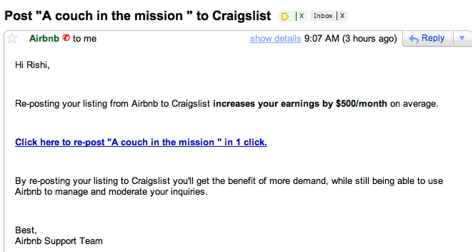If you’re a regular reader of the Ahrefs blog, then you’ll know that we usually keep our focus pretty tightly on SEO.
But since the goal of SEO is to grow your business, we feel it’s important that we take a step back and look at a broader set of marketing strategies and tactics every once in a while.
This time we’re looking at three well known companies:
- Salesforce
- Airbnb
- AdGrok
And the marketing strategies that got them their earliest successes.
Their methods were not directly SEO-focused. But each is a good example of how great marketing decisions can result in press coverage, referral traffic and organic links. Which of course leads to better rankings and search traffic.
Let’s get started with the first business — Salesforce.
Salesforce and the Guerrilla Marketing War
The SaaS industry has a reputation of being boring and “suited up.” But one of the earliest SaaS companies, Salesforce, was anything but boring. Especially when it came to marketing.
The key to their success was the fact that founder and CEO Marc Benioff would do anything and everything to get Salesforce’s name out there.
Above all, Benioff had a knack for knowing what the media wanted to see.
In 1999, while there were protests against the World Trade Organization in cities like Seattle (the home of Salesforce competitor Microsoft), he staged a protest of his own — outside a Siebel user conference:

On the right, radicals protesting the old order. On the left, a demonstration against the World Trade Organization. Seattle was crazy in ’99.
How Salesforce started to grow
Benioff’s protest was followed by a military-themed “End of Software” party. To get in, guests had to bring in a piece of “old software” to put in a set of “overflowing software trash bins.”
There were different themed areas at the party including “Software-Free Zones,” a “Prisoners of Software” area, and even a game area with a “Throw the Disk in the Toilet” game for anyone to play. The B52s played along with two other bands.
All in all, the event represented Salesforce’s value proposition from top to bottom:
- we were entering a world without software
- Salesforce was going to lead it
- it was going to be cool.
This huge party didn’t just get San Francisco’s tech scene excited. Tons of media outlets were already in town for the Siebel conference. Salesforce reached out to them and got the Wall Street Journal, Forbes and The New York Times all to attend the “End of Software” party. All of them wrote afterward about this brand-new startup willing to do anything to be noticed.
Business Insider, who also covered the event, referred to Salesforce as the “ant at [Siebel’s] picnic.” Today, that ant has a market cap of nearly $50 billion.
How not to do it
Things didn’t go so well for Benioff when he put up a controversial poster featuring the Dalai Lama. “There is no software on the path to enlightenment,” it read. The spiritual leader had been slated to speak at the Himalayan Foundation in San Francisco. He ended up publicly rejecting Benioff and his appropriation of his image.
We had no right to suggest that ht8qBxGtx&2r0QJsthe American Himalayan Foundation or His Holiness support us. We made a mistake
No one will mind a little fun if you keep it corporate. But keep people’s idols out of it.

Takeaways:
- Guerrilla marketing is all about punching up. No one makes a name for themselves attacking other small startups. People (media included) love a David and Goliath story. Find your Goliath and show how you’re different from them.
- Give media outlets a story that they want to cover. So many startups try to land PR spots early on when they have nothing to present beyond their product. The tech press likes scandals, conflict, and controversy. Give them something interesting or forget about PR, because it will often be a total waste of your time.
- Trust Me, I’m Lying: Confessions of a Media Manipulator by Ryan Holiday: Ryan Holiday was Director of Marketing for American Apparel and did publicity for Tucker Max. Needless to say, his book is a master class on the modern media system. Even the reported $500,000 advance Holiday received was said by some to be another media stunt designed to engineer hype for the book!
Airbnb and the Law of Shitty Clickthroughs
By coincidence, Airbnb also got its start at a conference. The story goes something like this:
- Three friends could not make rent on their apartment.
- A design conference was coming to San Francisco.
- They put two and two together and realized they could rent out some airbeds on their floor.
The plan worked, a company was born in the process.
As they wrote up their listing, the soon-to-be-founders discovered that Craigslist (the standard for apartment sublets at the time) was just not the best way. Craigslist was impersonal. Craigslist was already a little creepy. Their instincts told them to build something different.

The early Airbnb team working from the co-founders’ 3BR apartment complete with lofted ceilings, a bay window, hardwood floors, and a skylight. Wonder how much it costs to rent it today?
What became known as the “eBay of space” started to grow. But its founders didn’t lose sight of the fact that Craigslist was still the king. Craigslist was still where you went if you wanted to rent someone’s house or offer your own up. They had to find some way to access that massive market of potential Airbnb users.
How Airbnb started to grow
Sometime in 2010, Airbnb’s explosive growth began in earnest.
It all started from a “re-envisioning” of the guidelines in Craigslist’s terms of service. They hacked together an integration that let any listing on Airbnb be cross-posted to Craigslist. With its tens of thousands of users, it was a crucial market for the young startup:

Craigslist listings never looked so good.
With this technique, the Airbnb team short circuited the Law of Sh**ty Clickthroughs. In other words, the fact that “over time, all marketing strategies result in sh**ty clickthrough rates.”
The Law of Shitty Clickthroughs is why HotWired got a 78% click-through rate with the brand-new technique of banner ads in 1994. It’s why Facebook only got a 0.05% clickthrough rate in 2011.
To make your marketing stand out, you either need to do something novel or you need to deliver real value to your audience. And that’s what Airbnb did by giving their members access to a wider marketplace:

Airbnb emailed their users about cross-posting to Craigslist. They emailed Craigslist users about cross-posting to Airbnb.
In doing so, Airbnb could give something of value to both sides of the market. They were able to grow rapidly because of the additional exposure.
And because Airbnb was the first to truly take advantage of the Craigslist platform in this way, they got a huge novelty boost.
Finding this kind of edge is like catnip for growing startups. Having a product “that people want” is not enough. Even having a small audience of fans is not enough. You need to find what Justin Jackson calls “the fastest engine possible” and hook your product up to it.
Surfing on a bigger platform’s wave, as Airbnb did with Craigslist, is one of the best ways to do that — just remember that when it stops working you have to paddle out and catch another!
How not to do it
When you try to ride a competitor’s wave and wipe out, we call it sharecropping. You rented out a plot of land that someone else owned, you tried to farm it for personal gain, and then the landlord decided to evict you.
That’s exactly what happened to the YC-backed Zen99, which was formed to help freelancers figure out their taxes and find insurance.
Every user acquisition method the Zen99 team had tried failed. They finally decided that they should partner with a company with a huge presence in the tax space — Intuit — and try to grow that way.
Intuit processed hundreds of millions of tax returns every year, so riding that wave could be incredibly profitable.
Not long after, Intuit released QuickBooks - their own product that did exactly what Zen99 did. This made their partnership with Zen99 redundant.
Did Intuit just sign onto the partnership to learn what they could before turning around and building their own thing? Were there issues with the product? Doesn’t matter, in the end—the partnership ending was the last straw, and soon Zen99 put out a blog post called “Why Zen99 Shut Down.”
It’s not ideal when your best user acquisition strategy is partnering with a company who has a competing product
The lesson to take away is that sharecropping like Zen99 and, to a lesser extent, Airbnb, can be very dangerous. If the larger platform you’re using to get users to your product decides to pull the plug, you could be dead in the water.
Airbnb eventually did get shut out of Craigslist, but by then they’d already achieved a massive amount of growth using Craigslist’s platform. Intuit never let things get that far.
Takeaways:
- When you start a startup in a space that has a major player in it already (think Airbnb with Craigslist) tapping into that competitor’s market is a powerful way to kickstart your growth.
- Avoid sharecropping. You want to capitalize on another company’s market or model, not rely on it entirely. Better yet, give the company you’re piggybacking off of something of value. Airbnb helped increase Craigslist’s traffic even as they sought to use Craigslist to build out their own platform. Zen99 partnered with Intuit to offer a service that could be replicated too easily.
- The Four Steps to the Epiphany by Steven Blank: One of the classic startup books. His model of growth and acquisition was battle-tested through decades of building and growing startups. This is required reading for startup people.
- Traction by Gabriel Weinberg and Justin Mares: Few startup books have as much enthusiastic support from the founder/VC community as “Traction”. Mares and Weinberg take you through 19 different channels that successful entrepreneurs have used to kickstart growth.
AdGrok and the Blog Post as Firecracker
Before his company AdGrok was acquired by Twitter, Antonio Garcia-Martinez (author of the recent memoir Chaos Monkeys), was a physicist at Berkeley and a quant at Goldman Sachs.
But AdGrok’s first entree into the startup world didn’t come as a result of his team’s qualifications or even their product — it came through Garcia-Martinez’s writing on the AdGrok blog.

With the controversial and punchy “New York will always be a tech backwater, I don’t care what Chris Dixon or Ron Conway or Paul Graham say,” AdGrok began its ascent.
Garnering 180+ comments on Hacker News and driving 30,000 unique visitors to the AdGrok site, the post was a massive success.
How AdGrok started to grow
What made the post so relevant was that Hacker News, where the post was first submitted, was the domain of Y Combinator and its President and founder, Paul Graham. And Garcia-Martinez was attacking him head-on, explaining the “impossibility” of a true NYC startup scene by talking about the everyday social interactions he had in his life as a Goldman quant:
At cocktail parties with these people, the ‘ambitious ass-kickers’ Paul Graham thinks will save the New York tech scene, the second question you’re asked is inevitably “What do you do?” And so begins the not-so-subtle binning of you into your social echelon, more ritualistic and damning than any Japanese business card exchange ceremony.
Garcia-Martinez, like Benioff, knew that the way to get attention was to punch up.
By taking on a well-known VC, he knew he could get exposure. But to really capitalize on that exposure it couldn’t just be a controversial viewpoint he was taking — the content actually had to be good.
Fortunately for him, he was a good enough writer to make all those page views count.
How not to do it
So you wrote a piece you think is good and you want some help getting it on the front page of Hacker News.
That can work, but don’t make the mistake that Groove made and rely only on the upvotes of your friends and your colleagues to be enough in getting it to the front page of Hacker News.
The truth is that you have to actually have an interesting article that people would want to talk about. And for that readers have to be able to disagree with your point of view.
But don’t start talking religion or politics — create “strategic controversy,” an idea that Greg Ciotti illustrates by pointing to the very active internet debates over which way your toilet paper should hang off its roll.

Are you an “over” or an “under”? (Yes, this is seriously a thing.)
You can find niche controversies like this everywhere:
- Native advertising vs. content marketing
- Slack makes you productive vs. Slack is distracting
- Put two spaces after each period vs. put one space after each period
- Front-end Javascript framework #1 vs. Front-end Javascript framework #2
- New York City’s startup scene is working vs. New York City’s startup scene will never work
You get the idea. These are topics that have been written about a lot, but for very good reason — they’re debates and arguments that are never resolved.
If you have something compelling to say about a divisive topic, then people are going to pay attention.
Takeaway:
- If you want to make a statement about something in your field and generate some buzz - it’s not enough to be a competent writer and have the qualifications to back up what you say. Those are important, but if people are able to disagree with what you say, that will 10x the buzz.
- On Writing Well by William Zinsser: The classic writing guide. Zinsser isn’t writing for poets, playwrights, or essayists — “On Writing Well” is for anyone who needs to use and communicate with language in their work. Everyone can get some kind of use out of this book, whether it’s reducing their usage of clunky metaphors or simply writing with more clarity.
- Made to Stick by Chip and Dan Heath: this book answers a simple, but tricky question: “What makes certain ideas resonate with people?” Whether you’re building a product or writing a blog post, “Made to Stick” contains some useful nuggets of wisdom into how you can make what you’re doing more effective and more memorable.
Have some fun with your marketing
Let’s be honest, most of our marketing work is pretty repetitive and tedious:
- churning out new content every week;
- reaching out to hundreds of people;
- setting up advertising campaigns;
- writing newsletter updates;
- setting up new funnels, etc.
Moreover, the above-mentioned “conventional marketing strategies” are not as effective as we would like them to be - mainly because nearly exactly all of your competitors are doing pretty much the same stuff.
So wouldn’t it make sense to step out of the box from time to time and apply some creativity to your marketing? Obviously audacity doesn’t always work in your favour and it may as well backfire at you.
But do you think Marc Benioff would have managed to take Saleforce to $50 billion market cap without doing all these crazy things?
Let me know in the comments.






